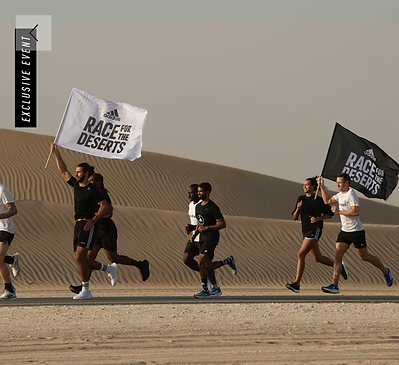
RACE FOR THE DESERTS DOCUMENTARY
MUHAMMED-RAFIQ

The Race For The Deserts is a fitness challenge event sponsored by Adidas, Dubai to spread awareness about the dangers of plastic waste in our environment. I had found out about the event on Instagram, I was interested in making the documentary about extreme sports, a fitness event geared towards preserving our environment and its ecosystems seemed like a story that should be told.


01
CONCEPT
The documentary would feature subjects in different fitness levels so as to get different perspectives on the topic/theme of the event. Introducing these distinct characters would widen the target audience since the documentary's goal is to spread the word about the event and the subject doesn't apply to a specific audience. My plan was to use at least, three different characters hoping that an audience would be familiar with either one of the characters, thus capturing the general audience as the characters discuss the subject of concern.
02
PREPRODUCTION
Anis and I signed up for the event as participants, the entire process was free and swift, simultaneously drafted a synopsis for the documentary, once we received our tickets, I made arrangements for filming equipment and prepared a production schedule. I attempted a location scout afterward, hoping to find the event location as the sponsors didn't reveal the exact location yet. It was difficult to determine what to expect given the uncertainty of the event location. I went on to reach out to a representative of the sponsors to request filming permission, but I received a negative response from him, only a few days before the event, saying they have designated coverage teams. So we decided to try again at the scene of the event and if denied, we would film with mobile phones instead.


03
The production budget only entails logistical expenses before production, however engaging in follow-up interviews could change that. The production would require a two-man crew, positioned in different areas in the event, to capture highlights of the day as we partake in the race. Once a filming request is granted, the crew would approach participants before the race to create rapport, and discuss the documentary with participants that match the desired character. We would follow them through the race and request interviews from them afterward. Once concluded, the crew will ensure interview subjects sign a release form before leaving the site.
PRODUCTION/BUDGET MANAGEMENT
04
AUDIENCE FEEDBACK/PERSONAL REFLECTION
At the Dignified Storytelling screening, I received several feedback/comments, all of which were positive and based on the entire film. No specific shot was criticized, but a friend I shared it with mentioned something about the intro, she mentioned that it seemed like a promotional video at the start rather than a documentary film, because of the texts describing the event in the video.
Personally, having watched the video several times, I became numb to the mood I was trying to convey with the epic score and the slight dynamic zoom I applied on the stills, I wanted the audience to feel a little empathy so as to realize the importance of the topic. I was worried this won't be passed across but seeing how they reacted as they watched and how they spoke about the film afterward, I believe I was able to achieve that with the film.
Technically, I made so many errors which I have learned from and will avoid in the future. I had a brief conversation with one of my characters before we scheduled an interview, to give him an insight into the subject of the interview. I thought that would prepare him but on the day of the interview, he could not speak fluently on camera, probably as a result of poor vocabulary, he was unable to find the right words to express himself which resulted in pauses during his speech. That caused the filming to take longer than expected, in the future I will arrange a rehearsal session before the actual filming.
When filming in the gym, I used autofocus since I was shooting with the camera rigged on a gimbal, and the shots involved a lot of movements. I had relied on the camera's autofocus capabilities but after reviewing my shots, most of them were out of focus. To avoid this in the future, I will use more still shots or use a digital focus-pulling system if available.
When filming in the desert, I shot on LOG profile, with the hope to recover my highlights, mid-tones, and shadows when color-correcting, but I couldn't because I recorded LONG GOP video format instead of ALL-INTRA, I did because the memory card writing speed does not support ALL-INTRA recording. In post-production, I was unable to retrieve the proper mid-tones without compromising my highlights. If I had used a color-checker, I would have been able to use it as a reference to retrieve the proper mid-tones. Alternatively, having a memory card with a faster writing speed would mean I could record in ALL-INTRA format, thus recording more color data. But regardless, I will always use a color-checker in the future. I also experienced an issue with the audio I recorded in the desert, one of the audio channels had a constant artificial note running through it, probably a fault in the mic. Though I recorded backup audio with a zoom recorder, I will make sure to check all audio equipment before going on set next time.
I had relied on too much stock footage/stills for cutaways in post-production, perhaps if I had dedicated more time to planning my shots in the pre-production process, I would have been able to gather more original content. Also, I will implement the use of reenacted shots in the future to create original content for cutaways.